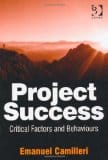Book review: Project Success: Critical Factors and Behaviours
This blog is reader-supported. When you purchase something through an affiliate link on this site, I may earn some coffee money. Thanks! Learn more.
Read our review guidelines.

The problem with a book on project success is that success means different things to different people. “[T]he perception of the stakeholders is fundamental to success,” Camilleri writes. He also points out the difference between project success (is the project a good thing) and project management success (was the project delivered in accordance to best practice). In order to address these, he has included bits of both in the book.
Project Success is based upon Camilleri’s literature research. He’s gone through academic papers since 1971 and looked at all the studies done into project success criteria. Then he has categorised them and ranked them by the number of times those criteria pop up in the research results. That gives us a list of the top things to work on to give ourselves a fighting chance of being successful. He writes:
“[T]he most important dimension for ensuring the successful implementation of projects, in order of priority, include:
- Project Planning and Control;
- Project Strategic Fit;
- Project Scope;
- Employee Commitment and Participation.”
These are the top four in a list of 11, and the rest of the book looks at each of them in turn.
The section on strategic fit is interesting. Whole books have been written about portfolio management and Camilleri has managed to squash project selection into 12 pages – and three of them are diagrams.
The book has plenty of diagrams, flow charts and even a scope definition template, but it still doesn’t feel like a practitioner’s book. For example, there are a few pages on assessing the project team environment and establishing whether it’s conducive to high performance. This is based on five measures:
- Level of role conflict and ambiguity within the project team
- Adequate definitions of roles and responsibilities
- Appropriate level of processes and procedures
- Level of collaboration within the team
- Level of cooperation between the project team and external stakeholders.
Each of these measures is the subject of a flow diagram. The flow diagrams provide a scoring system which ranks your project team. I can see the benefit of this for consultants, people joining a new company in roles where they can influence the outcome, or (maybe) new project managers joining a new team and who want to know what they have let themselves in for. But practical, day-to-day use? I don’t need to score the team environment. I live it – I already know.
In some areas the book is very detailed. For example, there is a good section on knowledge management and information flow. There’s a worked example of a project with start and end time constraints which explains float and resource levelling. But lessons learned is covered in just 5 lines.
One of the reasons I believe this is not a practitioner books is because it widely draws on management theory and is often concerned with the organisational layer, such as putting in place relocation and termination policies for employees. While you could have some influence at an individual level, this is not something most project managers can do.
To be fair to Camilleri, it isn’t meant to be a desk reference for the struggling project manager. If you are studying project management, or working as a consultant for failing projects, then this is a must-have read. If you are setting up a project management function from scratch in your company, then you’ll find Project Success very useful for starting off on the right foot. But the working project manager looking for a guide to doing day-to-day things right would be better off investing her reading time in something else.
This review first appeared in Project Tipoffs.
